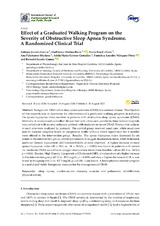Effect of a Graduated Walking Program on the Severity of Obstructive Sleep Apnea Syndrome. A Randomized Clinical Trial
Autor
Jurado-García, Antonio
Molina Recio, Guillermo
Feu-Collado, Nuria
Palomares-Muriana, Ana
Gómez González, Adela María
Márquez-Pérez, Francisca Lourdes
Jurado-Gámez, Bernabé
Editor
MDPIFecha
2020Materia
Sleep apneaCardiovascular diseases
Exercise and pulmonary rehabilitation
Physical activity
METS:
Mostrar el registro METSPREMIS:
Mostrar el registro PREMISMetadatos
Mostrar el registro completo del ítemResumen
Background: Obstructive sleep apnea syndrome (OSAS) is a common disease. The objective of this research was to determine the effectiveness of a graduated walking program in reducing the apnea–hypopnea index number in patients with obstructive sleep apnea syndrome (OSAS). Methods: A randomized controlled clinical trial with a two-arm parallel in three tertiary hospitals was carried out with seventy sedentary patients with moderate to severe OSAS. Twenty-nine subjects in each arm were analyzed by protocol. The control group received usual care, while usual care and an exercise program based on progressive walks without direct supervision for 6 months were offered to the intervention group. Results: The apnea–hypopnea index decreased by six points in the intervention group, and improvements in oxygen desaturation index, total cholesterol, and Low-Density Lipoprotein of Cholesterol (LDL-c) were observed. A higher decrease in sleep apnea–hypopnea index (45 ± 20.6 vs. 34 ± 26.3/h; p = 0.002) was found in patients with severe vs. moderate OSAS, as well as in oxygen desaturation index from baseline values (43.3 vs. 34.3/h; p = 0.046). Besides, High-Density Lipoprotein of Cholesterol (HDL-c) values showed a higher increase in the intervention group (45.3 vs. 49.5 mg/dL; p = 0.009) and also, a higher decrease in LDL-c was found in this group (141.2 vs. 127.5 mg/dL; p = 0.038). Conclusion: A home physical exercise program is a useful and viable therapeutic measure for the management of OSAS.

